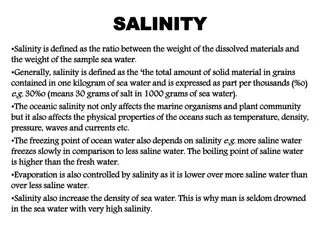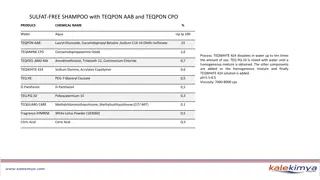Titration Colour Changes
This collection features various experiments in chemistry involving titration and solutions. It includes procedures such as standardizing hydrochloric acid using sodium carbonate, titrating hydrochloric acid with sodium hydroxide to produce sodium chloride, determining the concentration of ethanoic
0 views • 10 slides
Functional Safety and Cyber Security International Standards Update
This update covers various international standards related to functional safety and cyber security, including protocols like CSMA/CD, CSMA/CA, TSN, as well as standards for safety engineering tools and safety modules. It also highlights the collaboration with BSI standards for developing industry st
2 views • 16 slides
Spectrophotometric Determination of Copper Sulfate Concentration
The experiment aims to determine the concentration of an unknown copper (II) sulfate solution by measuring light absorption at different wavelengths. Colored solutions absorb specific light wavelengths and appear colored to our eyes. By creating a calibration curve and following Beer's Law, the conc
3 views • 8 slides
Overview of Internal Audit Standards and Accounting Standards
This content provides an overview of internal audit standards and accounting standards, emphasizing the importance of continuous professional development and updating in the field. It covers various accounting standards, including disclosures, valuation, revenue recognition, and more. Additionally,
5 views • 43 slides
Overview of Human Factors and Automotive Standards YouTube Series
This YouTube series, led by Paul Green from the University of Michigan, covers human factors and automotive standards. It includes topics like introduction to standards, core human factors standards, automotive human factors standards, human-computer interaction standards, and SAE vehicle standards.
7 views • 9 slides
Overview of Herbicides Classification and Groups
Herbicides are classified based on their chemical nature into inorganic and organic types. Inorganic herbicides, such as arsenic acid and copper sulfate, do not contain carbon atoms, while organic herbicides, like glyphosate and 2,4-D, contain carbon atoms. The classification includes various groups
4 views • 15 slides
Iron Ferrous Sulfate Market Size, Worth, Overview, Scope & Analysis to 2022-2029
Adroit Market Research has included the Global Iron Ferrous Sulfate Market\u00a0research to its database in order to provide a thorough analysis of the variables driving a general market growth trend. The study contains a lot of information and is a useful tool for professionals in the field.
0 views • 5 slides
Understanding Salinity in Seawater and Its Impacts
Salinity is the ratio of dissolved materials to the weight of seawater, affecting marine life and physical ocean properties like temperature, density, and waves. It influences freezing and boiling points, evaporation, and water density. Seawater composition includes salts like sodium chloride, magne
0 views • 11 slides
Efflorescence and Exsiccation in Chemistry
Efflorescence refers to the process where a substance loses water to form a lower hydrate or becomes anhydrous due to differences in vapor pressures. Hydrates with vapor pressures greater than the atmosphere tend to exhibit efflorescence. The rate of efflorescence increases with temperature. Exsicca
0 views • 103 slides
Overview of Rayon: Production, Properties, and Applications
Rayon, the first man-made fiber commercially produced, is a regenerated cellulosic material manufactured from wood pulp or cotton waste. Viscose rayon, the most common type, is produced through processes like the viscose method. Additives such as titanium dioxide, sodium sulfate, zinc sulfate, and g
0 views • 18 slides
Pediatric Dosage Calculations: Safe Medication Administration Guidelines
Learn how to calculate safe pediatric dosages for common medications such as Acetaminophen, Augmentin, Amoxicillin, and Ferrous Sulfate. Follow step-by-step instructions to determine the correct amount of medication to administer based on a child's weight and prescribed dosage. Ensure accuracy in do
1 views • 5 slides
Understanding Gypsum Products in Dentistry
Gypsum products play a crucial role in dentistry, serving as impression materials, die materials, and models. The classification of gypsum products includes impression plaster, model plaster, dental stone, and high-strength variations. The manufacturing process varies for dental plaster and stone, w
2 views • 41 slides
Chemical Analysis and Redox Reactions in Chemistry
Iron(II) ethanoate concentration determination using redox titration with cerium(IV) sulfate, balanced redox equations for manganate(VII) ion oxidizing iron(II) ion, and calculations of iron percentage in samples using titration with potassium manganate(VII). Molarities and concentrations are calcul
1 views • 6 slides
Understanding Redox Reactions in Chemistry
Salts can be prepared through redox reactions involving metals and acids. This interactive lesson covers oxidation numbers, identifying oxidized and reduced elements, and explaining electron transfer in redox reactions. Examples include reactions of aluminum with sulfuric acid and magnesium with cop
2 views • 12 slides
Premium Sulfate-Free Personal Care Products with Teqpon
Discover a range of premium sulfate-free personal care products featuring Teqpon technology. From a gentle sulfate-free shampoo to a versatile nonionic fabric softener, each product is meticulously formulated with high-quality ingredients to cater to different personal care needs. The Teqpon technol
3 views • 8 slides
Milk and Milk Products: Regulations and Standards in India
The regulations and standards for milk and milk products in India are governed by national bodies such as PFA, AGMARK, BIS, and FSSAI. Legal standards set by the government ensure minimum requirements for quality, composition, hygiene, labeling, and packaging. Quality standards, like BIS and Agmark,
2 views • 36 slides
Back Titration in Analytical Chemistry
Back titration is a technique used in analytical chemistry to determine the concentration of an analyte by reacting it with an excess of another reagent first, followed by titration of the excess reactant. This method is especially useful in cases where direct titration endpoints are difficult to di
2 views • 14 slides
Overview of Cement: Types, Composition, and Functions
Cement is a vital building material consisting of various compounds like lime, silica, and alumina. It is used in mortar and concrete. The chemical composition of cement includes elements like iron oxide and gypsum. Different types of cement serve specific purposes such as rapid hardening or sulfate
0 views • 29 slides
Redox Titration: Potassium Permanganate with Iron(II) Salt Assay
Ferrous sulfate (FeSO4.7H2O) is used in medical treatments for iron deficiency. This article discusses the redox titration process involving potassium permanganate and ferrous sulfate, along with the chemical principles, procedure, and calculations involved. Potassium permanganate is a powerful oxid
5 views • 7 slides
Tanzania Bureau of Standards: Managing E-Waste with Standards
Tanzania Bureau of Standards (TBS), established in 1975, plays a vital role in formulating and implementing national standards, including those for managing e-waste. Standards ensure quality, safety, and sustainability in materials, products, and services. TBS follows international best practices in
0 views • 22 slides
Clinical Audit Results of Moderate to Acute Severe Asthma in EDs 2016/17
This clinical audit presentation showcases the national results of how Emergency Departments (EDs) are performing against the established audit standards for moderate to acute severe asthma in the year 2016/17. The objectives of the audit were to benchmark current performance, enable national and pe
1 views • 36 slides
Understanding Pre-eclampsia and Eclampsia: Prevention and Management
Learn about the prevention, identification, and management of pre-eclampsia and eclampsia, which are significant causes of maternal mortality globally. This session covers definitions of hypertensive disorders of pregnancy, supportive care for women with eclampsia, and the administration of injectio
1 views • 15 slides
Protein Desalting Techniques for Biochemical Purification
Protein desalting is crucial for purifying proteins after an ammonium sulfate precipitation step, which may leave the protein in a high-salt buffer. Three common desalting methods include dialysis using semi-permeable membranes, gel filtration with Sephadex G25 to exclude salts, and ultrafiltration
4 views • 6 slides
Optimized Standards for Medical Device Safety and Performance in the EU
This report discusses the importance of harmonized standards in supporting the safety and performance of medical devices in the EU. It highlights the impact of drafting international medical device standards on EU legislation harmonization and emphasizes the role of harmonized standards under the EU
0 views • 8 slides
ANSI C12.1 Overview and Current Events
ANSI C12.1 standards are integral to the electric metering industry. The standards, managed by the American National Standards Institute (ANSI) and NEMA, promote voluntary compliance. NEMA plays a crucial role as the secretariat, overseeing committees that propose and review standards every five yea
0 views • 32 slides
Understanding PM2.5 in Korea and China Through Integrated Modeling and Analysis
Improved understanding of PM2.5 in Korea and China is achieved through integrated modeling of satellite, aircraft, and surface observations. Studies show fast oxidation of SO2 to sulfate PM during winter haze events, with correlations of sulfate with nitrogen oxides explained in-depth. The persisten
0 views • 13 slides
Exploring Copper Sulfate, Sodium Nitrate, and Ammonium Chloride in Chemistry Projects
Delve into the properties and uses of copper sulfate, sodium nitrate, and ammonium chloride in chemistry projects. Discover how these chemical compounds play vital roles in agriculture, industry, and everyday applications, from fungicides to food additives.
0 views • 9 slides
NUSSC 57th Meeting - End of Term Report & Safety Standards Update
The 57th Meeting of the Nuclear Safety Standards Committee (NUSSC) concluded its 9th term with significant achievements including the approval and publication of multiple safety standards. Key highlights include the development of new standards such as SSG-3, SSG-88, SSG-89, and SSG-90 focusing on v
0 views • 8 slides
Role of Statistical Standards in Building National Data Backbones
The role of statistical standards in constructing national data backbones is crucial for efficient data dissemination and reporting, especially in the context of Sustainable Development Goals (SDGs). Statistical standards guide the orchestration of information flows within a national statistical net
0 views • 22 slides
Development of Harmonized North American Life Jacket Standards
The development of harmonized North American life jacket standards led by Brandi Baldwin in the Lifesaving & Fire Safety Division at the Office of Design & Engineering Standards is a crucial regulatory process. It involves regulatory progress, standards development, consensus processes, and ongoing
0 views • 16 slides
Understanding Different Types of Cement for Construction
Cement is a crucial component in concrete and mortar, with various types available based on specific project requirements. Types include Ordinary Portland Cement for general construction, Modified Portland Cement for sulfate resistance, High Early Strength Cement for quick setting, Low Heat Portland
0 views • 5 slides
Understanding Different Types of Cement
White Portland Cement (WPC) is ideal for architectural use due to its low iron and manganese oxide content, while High Alumina Cement (HAC) offers rapid hardening and sulfate resistance. Portland Pozzolan Cement provides greater sulfate attack resistance and is suitable for marine and hydraulic cons
0 views • 5 slides
Understanding North Atlantic Hurricane Drought and Aerosol Impact
This study explores the influence of sulfate aerosols on the late 20th-century North Atlantic Hurricane drought, focusing on the interaction of European sulfate aerosols and African dust. It investigates the radiative forcing effects and variability in hurricane activity, proposing hypotheses relate
0 views • 17 slides
Protein Purification Techniques and Ammonium Sulfate Precipitation
Protein purification is a crucial process in biotechnology to isolate specific proteins from complex mixtures. Techniques such as exploiting physio-chemical properties, binding affinity tags, and biological activity are used. Ammonium sulfate precipitation, a common first step, involves adding incre
0 views • 60 slides
Protecting Wild Rice in Minnesota: Sulfate Standards and Environmental Preservation
Understanding the importance of safeguarding wild rice in Minnesota due to its cultural, spiritual, and economic significance along with its sensitivity to sulfate pollution. Exploring sources of sulfate, the sulfate-sulfide relationship, and proposed solutions for maintaining wild rice populations.
0 views • 10 slides
Health Data Interchange Standards Overview
Explore the importance of data standards in healthcare, including HL7 standards, core requirements for data exchange, and choices for data interchange. Learn about HL7 v2 and v3 messaging standards, document standards, and the benefits of using HL7 v2 messaging standard. Understand why data intercha
0 views • 28 slides
Assay of Ferrous Sulfate (FeSO4.7H2O) by Redox Titration Experiment
This experiment involves determining the weight and weight percentage of an unknown sample of FeSO4.7H2O through a redox titration using potassium permanganate solution. Ferrous sulfate, a chemical compound used in medical treatments, is oxidized to ferric sulfate in the presence of sulfuric acid. T
0 views • 9 slides
Understanding Nebraska's Road Design Standards
Explore the Nebraska Administrative Code Title 428, which outlines the standards and regulations for public roads in Nebraska, including county roads and municipal streets. Learn about terminology, acronyms, and design tables to find the appropriate standards for road and street work. Discover the p
0 views • 51 slides
EHFA Standards in the Fitness Industry
The EHFA Standards Council has developed a series of standards for fitness occupations, focusing on job purpose as the foundation for qualifications. EHFA provides guidance on standards for people, programs, and places in the health and fitness sector. Since 2003, EHFA has been setting standards for
0 views • 19 slides







































